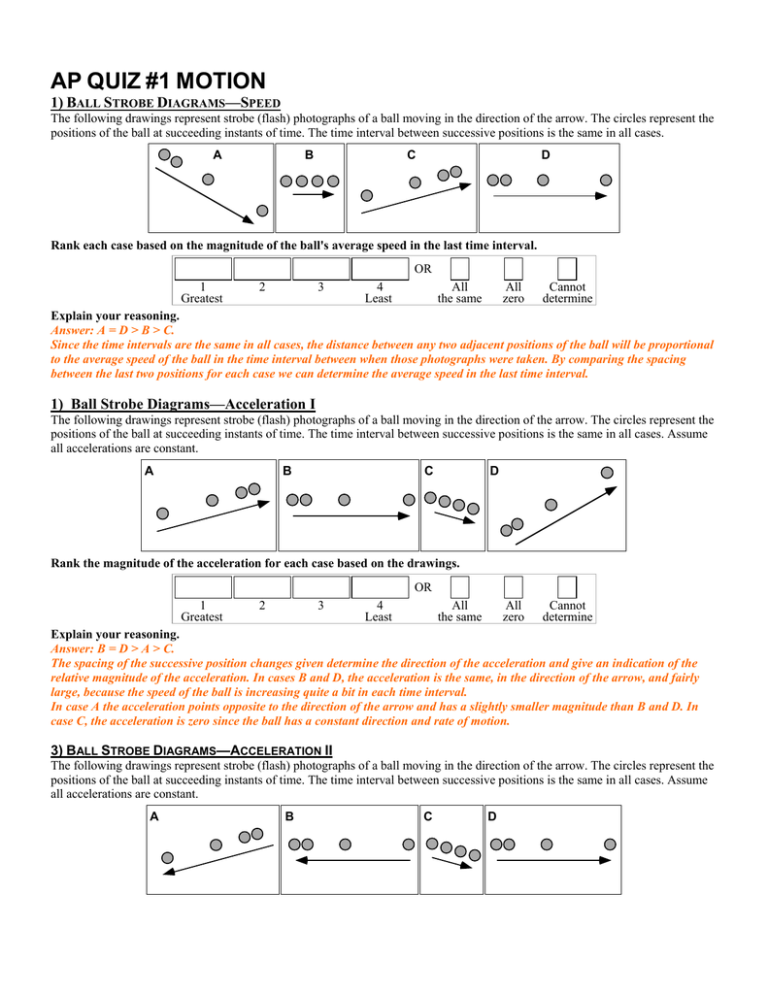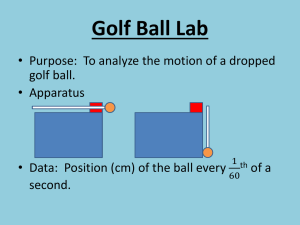AP FR Quiz #1 Motion
advertisement

AP QUIZ #1 MOTION 1) BALL STROBE DIAGRAMS—SPEED The following drawings represent strobe (flash) photographs of a ball moving in the direction of the arrow. The circles represent the positions of the ball at succeeding instants of time. The time interval between successive positions is the same in all cases. A B C D Rank each case based on the magnitude of the ball's average speed in the last time interval. OR 1 Greatest 2 3 4 Least All the same All zero Cannot determine Explain your reasoning. Answer: A = D > B > C. Since the time intervals are the same in all cases, the distance between any two adjacent positions of the ball will be proportional to the average speed of the ball in the time interval between when those photographs were taken. By comparing the spacing between the last two positions for each case we can determine the average speed in the last time interval. 1) Ball Strobe Diagrams—Acceleration I The following drawings represent strobe (flash) photographs of a ball moving in the direction of the arrow. The circles represent the positions of the ball at succeeding instants of time. The time interval between successive positions is the same in all cases. Assume all accelerations are constant. A B C D Rank the magnitude of the acceleration for each case based on the drawings. OR 1 Greatest 2 3 4 Least All the same All zero Cannot determine Explain your reasoning. Answer: B = D > A > C. The spacing of the successive position changes given determine the direction of the acceleration and give an indication of the relative magnitude of the acceleration. In cases B and D, the acceleration is the same, in the direction of the arrow, and fairly large, because the speed of the ball is increasing quite a bit in each time interval. In case A the acceleration points opposite to the direction of the arrow and has a slightly smaller magnitude than B and D. In case C, the acceleration is zero since the ball has a constant direction and rate of motion. 3) BALL STROBE DIAGRAMS—ACCELERATION II The following drawings represent strobe (flash) photographs of a ball moving in the direction of the arrow. The circles represent the positions of the ball at succeeding instants of time. The time interval between successive positions is the same in all cases. Assume all accelerations are constant. A B C D Rank the magnitude of the acceleration in each case, based on the drawings. OR 1 Greatest 2 3 4 Least All the same All zero Cannot determine Explain your reasoning. Answer: B = D > A > C. The acceleration is the rate of change of the velocity. Since the velocity of C is constant the acceleration is zero for that case. For the others we can look at the changes in the average velocities, which are proportional to the changes in the spacing between successive locations. These are equivalent for B and D, but A has a smaller magnitude acceleration. B1-RT04: Strobe Photographs of Spheres—Displacement In each case, a sphere is moving from left to right next to a tape marked in meters. A strobe (flash) photograph is taken every second, and the location of the sphere is recorded. The total time intervals shown are not the same for all spheres. A B C D 0 1 2 3 4 5 6 7 8 9 10 m 0 1 2 3 4 5 6 7 8 9 10 m 0 1 2 3 4 5 6 7 8 9 10 m 0 1 2 3 4 5 6 7 8 9 10 m Rank these spheres on the greatest displacement over the first 3 seconds. OR 1 Greatest 2 3 4 Least All the same All zero Cannot determine Explain your reasoning. Answer: C = D > A > B. The displacements for C and D during the first three seconds was 9 m, next was A at 6 m and least is B at 2 m. 4) STROBE PHOTOGRAPHS OF SPHERES—AVERAGE VELOCITY In each case, a sphere is moving from left to right next to a tape marked in meters. A strobe (flash) photograph is taken every second, and the location of the sphere is recorded. The total time intervals shown are not the same for all spheres. A B C D 0 1 2 3 4 5 6 7 8 9 10 m 0 1 2 3 4 5 6 7 8 9 10 m 0 1 2 3 4 5 6 7 8 9 10 m 0 1 2 3 4 5 6 7 8 9 10 m Rank these spheres on the greatest average velocity over the first 3 seconds. OR 1 Greatest 2 3 4 Least All the same All zero Cannot determine Explain your reasoning. Answer: C = D > A > B. Average velocity is defined as the displacement during a time interval divided by the time interval. The time interval is the same for all four cases, so the average velocities are determined by the displacements, which are proportional to the distances traveled in the first three seconds. 5) Vertical Model Rockets—Maximum Height The model rockets depicted below have just had their engines turned off when they are at the same height. All of the rockets are aimed straight up, but their speeds differ. Although they are the same size and shape, the rockets carry different loads so their masses differ. The specific mass and speed for each rocket is given in each figure. A B C D 30 m/s 40 m/s 20 m/s 20 m/s 700 g 500 g 600 g 500 g Rank these model rockets on the maximum height they will reach. OR 1 Greatest 2 3 4 Least All the same All zero Cannot determine Explain your reasoning. Answer: B > A > C = D. All four experience the same acceleration of 9.8 m/s2 downward, so their maximum heights are determined by their speed. Ignoring air resistance all objects have the same acceleration in the Earth’s gravitational field whatever their masses. 6) Change of Velocity In each figure below, a car’s velocity is shown before and after a short time interval. A C Before After +10 m/s +20 m/s Before After +10 m/s -10 m/s B D Before After +10 m/s 0 Before +30 m/s After +20 m/s Rank these situations on the magnitude of the change in velocity during the time interval. OR 1 Greatest 2 3 4 Least All the same All zero Cannot determine Explain your reasoning. Answer: C > A = B = D. The magnitude of the change in velocity for C is 20 m/s while the other three all have 10 m/s velocity changes. 7) PEOPLE ON TRAINS—SPEED RELATIVE TO GROUND In each case shown, someone is running on a flatbed train car as the train moves. In cases C and D, the person is running toward the front of the train, while in cases A and B the person is running toward the rear. The speeds of the train and of each person relative to the train are given. An observer is standing beside the track watching each train go by. A B vP = 8 m/s vP = 10 m/s vT = 30 m/s vT = 24 m/s C vP = 12 m/s D vP = 4 m/s vT = 20 m/s vT = 16 m/s Rank these runners on how fast they are moving relative to the observer standing beside the tracks. OR 1 Greatest 2 3 4 Least All the same All zero Cannot determine Explain your reasoning. Answer: C > B = D > A. The observer would see the runner moving at 32 m/s in C, 20 m/s in B and D, and 16 m/s in A. 8) Moving Asteroids near Observer Spaceship—Velocity Direction Shown are five asteroids and a spaceship, all moving in the same direction away from the earth. The velocities of the asteroids and of the spaceship are given as measured from the earth. A B C D 600 m/s 700 m/s 800 m/s 400 m/s E 400 m/s 600 m/s (1) List the asteroids that are moving toward an observer on the spaceship. B and C and E (2) List the asteroids that are moving away from an observer on the spaceship. D. Explain your reasoning. Asteroids B and E will be moving to the left at 100 and 200 m/s relative to an observer on the spaceship. Asteroid A will be at rest relative to the spaceship. And asteroid C will be moving to the right at 200 m/s relative to the spaceship. The asteroids moving toward an observer on the spaceship are therefore B, C and E, and the one moving away from the observer is D.




